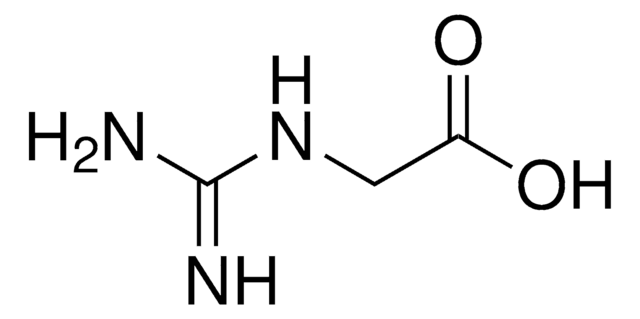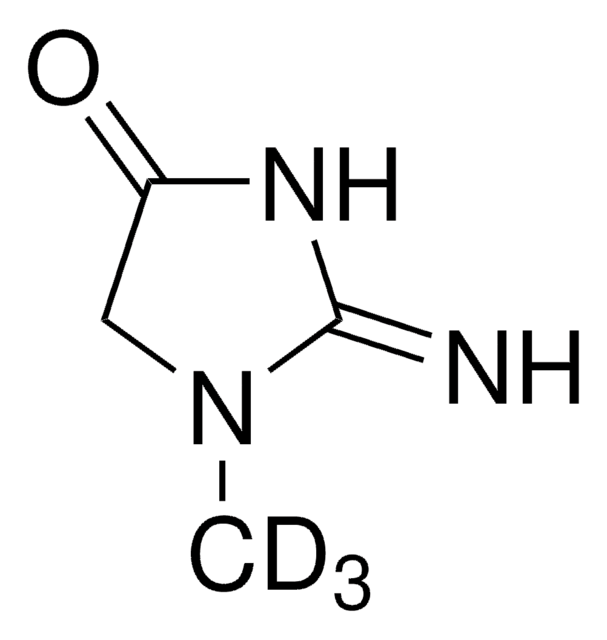C3630
Creatine monohydrate
≥98%, suitable for cell culture
동의어(들):
Creatine hydrate, Creatine, monohydrate, N-(aminoiminomethyl)-N-methyl-glycine hydrate
로그인조직 및 계약 가격 보기
모든 사진(1)
About This Item
실험식(Hill 표기법):
C4H9N3O2 · H2O
CAS Number:
Molecular Weight:
149.15
Beilstein:
7942755
EC Number:
MDL number:
UNSPSC 코드:
12352209
PubChem Substance ID:
NACRES:
NA.26
추천 제품
애플리케이션
Creatine (Cr) and phosphocreatine (PCr) are involved with rapid ATP production primarily in skeletal muscle tissue via the action of creatine kinase(s). Creatine may be used as a supplement to study its uptake mechanism and metabolism of action.
생화학적/생리학적 작용
Creatine is a nitrogenous compound that acts as a high-energy reservoir for the rapid regeneration of ATP. Approximately 95% of creatine is found in skeletal muscle, primarily as phosphocreatine. Creatine can be acquired through dietary consumption or formed from L-arginine, glycine, and L-methionine in a multi-step reaction that occurs in the kidneys and liver. Creatine is then transported to muscle tissue. Creatine supplementation is used for the enhancement of sports performance, primarily by increasing muscle mass. Creatine is also being investigated as a treatment of neuromuscular diseases, where it may aid in neuroprotection and by improving the cellular bioenergetic state.
Storage Class Code
11 - Combustible Solids
WGK
WGK 3
Flash Point (°F)
Not applicable
Flash Point (°C)
Not applicable
개인 보호 장비
dust mask type N95 (US), Eyeshields, Gloves
시험 성적서(COA)
제품의 로트/배치 번호를 입력하여 시험 성적서(COA)을 검색하십시오. 로트 및 배치 번호는 제품 라벨에 있는 ‘로트’ 또는 ‘배치’라는 용어 뒤에서 찾을 수 있습니다.
이미 열람한 고객
Jeffrey S Martin et al.
Journal of the International Society of Sports Nutrition, 14, 38-38 (2017-09-30)
We sought to determine if a pre-workout supplement (PWS), containing multiple ingredients thought to enhance blood flow, increases hyperemia associated with resistance training compared to placebo (PBO). Given the potential interaction with training loads/time-under-tension, we evaluated the hyperemic response at
Andrina Stäubli et al.
Human molecular genetics, 26(21), 4203-4214 (2017-11-01)
Membrane transporters influence biological functions in the ocular lens. Here, we investigate the monocarboxylate transporter 12 (MCT12), also called creatine transporter 2 (CRT2), which is found in the ocular lens and is involved in cataract. As the age-related form affects
Caro-Lyne DesRoches et al.
Gene, 565(2), 187-191 (2015-04-12)
Creatine transporter deficiency (CRTR-D) is an X-linked inherited disorder of creatine transport. All males and about 50% of females have intellectual disability or cognitive dysfunction. Creatine deficiency on brain proton magnetic resonance spectroscopy and elevated urinary creatine to creatinine ratio
Clare E Turner et al.
The Journal of neuroscience : the official journal of the Society for Neuroscience, 35(4), 1773-1780 (2015-01-30)
Impairment or interruption of oxygen supply compromises brain function and plays a role in neurological and neurodegenerative conditions. Creatine is a naturally occurring compound involved in the buffering, transport, and regulation of cellular energy, with the potential to replenish cellular
Domenic A LaRosa et al.
Pediatric research, 80(6), 852-860 (2016-07-29)
Maternal antenatal creatine supplementation protects the brain, kidney, and diaphragm against the effects of birth asphyxia in the spiny mouse. In this study, we examined creatine's potential to prevent damage to axial skeletal muscles. Pregnant spiny mice were fed a
자사의 과학자팀은 생명 과학, 재료 과학, 화학 합성, 크로마토그래피, 분석 및 기타 많은 영역을 포함한 모든 과학 분야에 경험이 있습니다..
고객지원팀으로 연락바랍니다.










